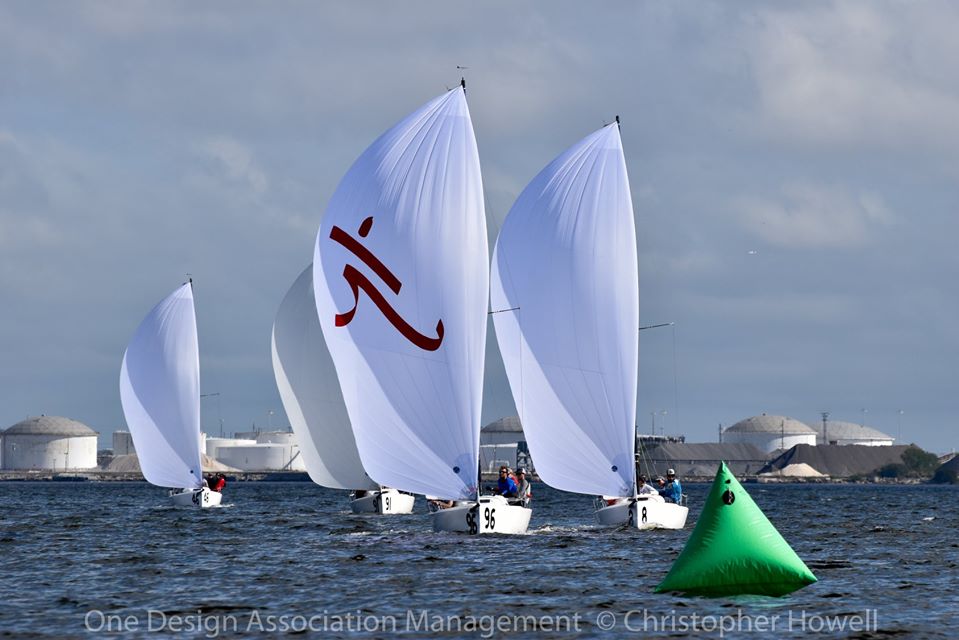Learn from sailing data: Downwind Technique
Charles Swanson contributes to ChartedSails and is a winning competitive sailor. Charles is also the Sales & Support Manager at Velocitek. Prior to Velocitek, Charles worked on America's Cup winning electronics at Ockam Instruments.

The corollary to Ed Baird’s “Losing a quarter of a boatlength less than your opponent in each tack means one length gained in a four-tack beat.” Must be “losing a quarter of a boatlength less than your opponent in each gybe means one length gained in a four-gybe run.” (from Staying on Target).
In many modern classes a four-gybe run might be a lot of maneuvers but you get the point; fractional boat lengths matter.
Just like we learnt from good and bad tacks looking at the shape of the turn and the speed through the maneuver can tell us a lot about a gybe. Again, this is very easy to do using ChartedSails and the data from your Velocitek ProStart. Using the speed colored tails, boat card and stripchart, quantitative and qualitative analysis is easy.
Once again, you can look at each gybe in three parts: entry, turn and exit:
For the entry you want to see that you are on your VMG angle and traveling at target speed into the turn.
During the turn you want to see that the momentum is carried downwind (and down the course) and you have a nice smooth turn (consistent rate of turn). Just like tacks the rate of turn will vary with wind and sea conditions and generally speaking, you want a consistent rate of turn in each maneuver.
For the exit you want to see that the turn stops at a good acceleration or speed build angle, the boat is able to accelerate straight away and there is no searching for exit angle.
Follow Along!
For this blog post, we invite you to follow along on your computer. We will be looking at the first gybe of the race. Note that most of the tools we use here are only available on the computer version so you might want to wait until you are home to try this.
- Open the J70 racing at Davis Island session
- Click on the "First gybe" bookmark (in the timeline) to focus on the first gybe.
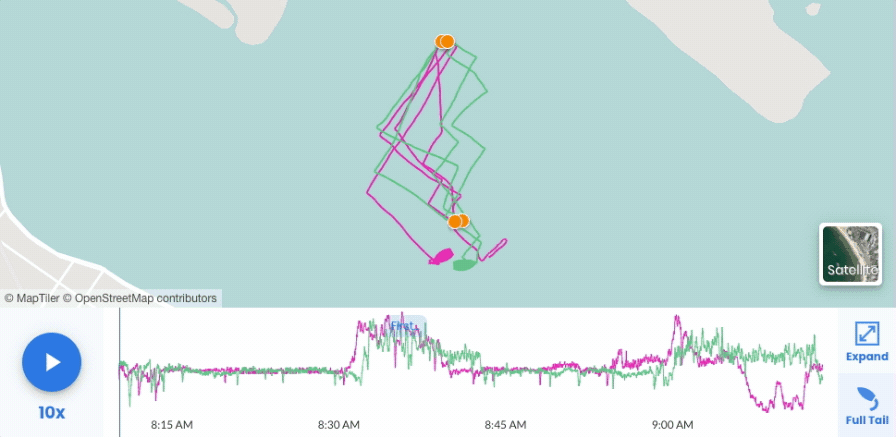
Entry
Green is S-ing and you can see (switch to the speed-colored tail) that the speed is going up and down . This is a topic that is probably worth another post all to its own. Stand by for that...
Approaching the turn you see Green get slow (from 11kts down to 7kts). To rebuild speed, they head up and then gybe. This may have been traffic related but it is not ideal if you are in open water.
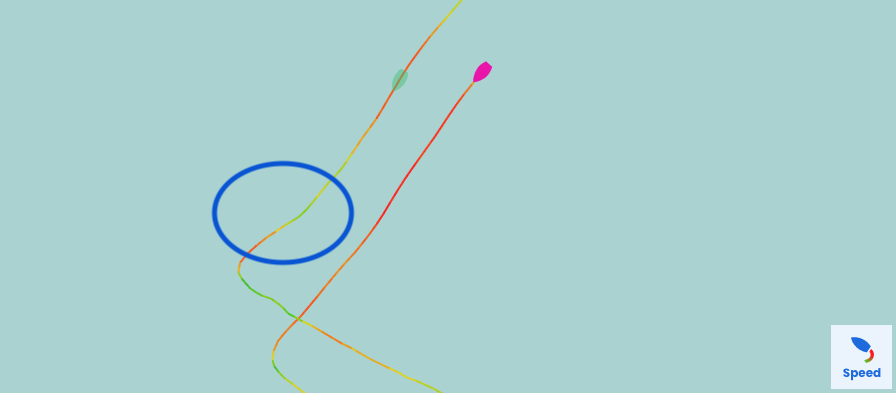
Pink, on the other hand, is steering a much tighter groove. The course and speed vary much less than Green. Going into the gybe there is little or no change in course and speed.
Using the ChartedSails boat cards we see Pink enters at 10.4 of boatspeed and 7.6 VMG.

Green enters at 10.9 knots with 7.2 knots of VMG. Green has an additional 0.5 knots of boatspeed but 0.4 knots less VMG. Quantitatively we can see that the turn up was too large and the boat is sailing too high going into the gybe.
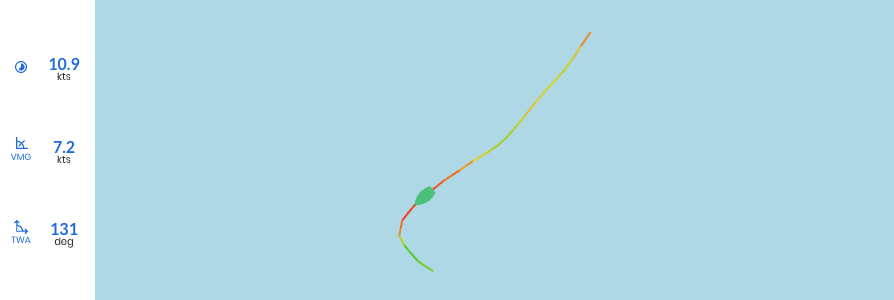
How does the turn up before the gybe impact your race?
First, you lose gauge down the course. You’re sailing across the course instead of down it, towards the leeward mark.
Second, it is harder to judge your turn and your exit angle. Because you’ve just headed up you can more easily get lost in the turn and misjudge your exit angle. If you’re a numbers person, and you do some quick math to pick your exit angle, you might pick an angle that is too low because you were artificially high when you started the gybe.
Third, momentum. Because you just headed up, you now need to turn through a greater number of degrees. This means you’ll use more rudder (which acts as a brake) or you’ll be turning for a longer period of time. Either way, you’ll carry less momentum out of the turn.
Turn
Green has a much sharper turn. With the quick turn down Green enters the gybe with 9.8kts of boatspeed and is doing 8.4 knots of boatspeed (also VMG) at dead-downwind and they get there fast. At a glance these figures appear great but the turn happens so quickly that the benefit from the bear away is short lived. What happens next is that the rate of turn remains high and the speed and VMG plummet.

A fast turn also makes it tough on the crew who have less time to do their sail handling and boat handling through the turn. And because everything is happening so quickly, the driver has less time to pick their exit angle.
Pink has a nice smooth turn. Their speed and VMG are not as high as Green but their low speeds are much higher as they are able to carry more momentum through the bear away into the turn and down the course.

Using the ChartedSails boat card we can see that Green travels 94 meters in 22 seconds and Pink travels 99 meters in the same time (centered around their respective gybes).
Exit
Green had a wiggle up then down then back up searching for the exit. While minor, all of this driving loses gauge, burns speed and makes things more challenging for the trimmers.
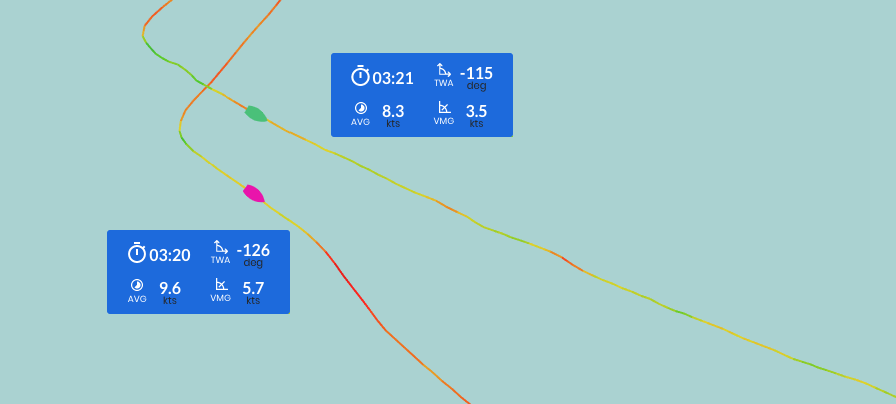
Pink exits straight, accelerates and then bears away (likely as a puff hits). Looking at the track we see a nice steady course out of the gybe. There is no searching for the exit angle. Using the heat mapped track and the speed stripchart you see the speed bottoms and turns as the boat accelerates and then the big acceleration and bear away as they link up with the next puff.
Moving the mouse over the track, we can see that after the gybe, Pink's VMG is 5.7kts while Green who is sailing higher and slower only has a VMG of 3.5kts.
Conclusion
Driving a sailboat well takes an incredible amount of practice and focus. It is way easier to be a Monday-morning quarterback and pick apart maneuvers in a debrief than it is to execute them well in the heat of battle. But continuous improvement and learning is the name of the game.
Using ChartedSails makes it easy for sailors and coaches to debrief a day of sailing. The more you can learn from a day on the water, the better you can be the next day.
Here we looked at data from two different boats and looking at one maneuver we can learn a lot about technique and ways to improve. If you have not done so already, open up this J70 replay and take a look at the next gybe.
Recording sailing data is easy, upload your own data and get a friend in your fleet to do the same to start the group learning in this extended off season, this sailing season, and beyond!

